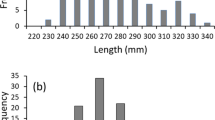Abstract
The feeding behaviour ofClupea harengus L. in the light is dependent primarily on prey concentration. In the laboratory the fish feed by biting at low prey concentrations and by filtering at high concentrations. With the brine shrimpArtemia sp. as prey, the concentration required for the onset of filter-feeding was directly dependent on prey size, but the concentration at which 50% of feeding fish were filtering differed little between three sizes of brine shrimp (nauplii, and 2 and 4 mm larvae). When fed onCalanus finmarchicus, however, 50% of fish fed by filtering at concentrations at least six times lower than on any size of brine shrimp. Filter-feeding thresholds forC. finmarchicus were six to ten times lower than for any size ofArtemia sp. and, on the basis of biomass, approximately eight times lower than for equivalent sizedArtemia sp.
Similar content being viewed by others
Literature cited
Batty, R. S., Blaxter, J. H. S., Libby, D. A. (1986). Herring (Clupea harengus) filter-feeding in the dark. Mar. Biol. 91: 371–375
Batty, R. S., Blaxter, J. H. S., Richard, J. M. (1990). Light intensity and the feeding behaviour of herring,Clupea harengus Mar. Biol. (in press)
Bossuyt, E., Sorgeloos, P. (1980). Technological aspects of the batch culturing ofArtemia in high densities. In: Persoone, G., Sorgeloos, P., Roels, O. A., Jaspers, E. (eds.) The brine shrimpArtemia. Vol. 3. Ecology, culturing, use in aquaculture. Universa Press, Wetteren, Belgium, p. 133–152
Crowder, L. B. (1985). Optimal foraging and feeding mode shifts in fishes. Envir. Biol. Fish. 12: 57–62
Crowder, L. B., Binkowski, F. P. (1983). Foraging behaviours and the interaction of alewife,Alosa pseudoharengus, and bloater,Coregonus hoyi. Envir. Biol. Fish. 8: 105–113
Dempsey, C. H. (1978). Chemical stimuli as a factor in feeding and intraspecific behaviour of herring larvae. J. mar. biol. Ass. U.K. 58: 739–747
De Silva, S. S. (1973). Food and feeding habits of the herringClupea harengus and the spratC. sprattus in inshore waters of the west coast of Scotland. Mar. Biol. 20: 282–290
Durbin, A. G. (1979). Food selection by plankton feeding fishes. In: Clepper, H. (ed.) Predator-prey systems in fisheries management. Sport Fishing Institute, Washington, D.C., p. 203–218
Durbin, A. G., Durbin, E. G. (1975). Grazing rates of the Atlantic menhadenBrevoortia tyrannus as a function of particle size and concentration. Mar. Biol. 33: 265–277
Gibson, R. N. (1988). Development, morphometry and particle retention capability of the gill rakers in the herring,Clupea harengus L. J. Fish Biol. 32: 949–962
Gibson, R. N., Ezzi, I. A. (1985). Effect of particle concentration on filter- and particulate-feeding in the herringClupea harengus. Mar. Biol. 88: 109–116
Hardy, A. C. (1924). The herring in relation to its animate environment. Part I. The food and feeding habits of the herring with special reference to the east coast of England. Fishery Invest., Lond. (Ser. 2) 7(3): 1–53
Hardy, A. C. (1959). The open sea: its natural history. Part II. Fish and fisheries. Collins, London
Haury, L. R., Kenyon, D. E., Brooks, J. R. (1980). Experimental evaluation of the avoidance reaction ofCalanus finmarchicus. J. Plankton Res. 2: 187–202
Hewlett, P. S., Plackett, R. L. (1979). An introduction to the interpretation of quantal responses in biology. Edward Arnold, London
Holanov, S. H., Tash, J. C. (1978). Particulate and filter feeding in threadfin shad,Dorosoma petenense, at different light intensities. J. Fish Biol. 13: 619–625
Hunter, J. R., Dorr, H. (1982). Thresholds for filter feeding in northern anchovy,Engraulis mordax. Rep. Calif. coop. ocean. Fish. Invest. (CalCOFI). 23: 198–204
James, A. G., Findlay, K. P. (1989). The effect of particle size and concentration on the feeding behaviour, selectivity and rates of ingestion of food by the Cape anchovyEngraulis capensis Gilchrist. Mar. Ecol. Prog. Ser. 50: 275–294
Janssen, J. (1976). Feeding modes and prey size selection in the alewife (Alosa pseudoharengus). J. Fish. Res. Bd Can 33: 1972–1975
Janssen, J. (1978a). Will alewifes (Alosa pseudoharengus) feed in the dark? Envir. Biol. Fish. 3: 239–240
Janssen, J. (1978b). Feeding-behaviour repertoire of the alewife,Alosa pseudoharengus, and the ciscoesCoregonus hoyi andC. artedii. J. Fish. Res. Bd Can. 35: 249–253
Janssen, J. (1980). Alewifes (Alosa pseudoharengus) and ciscoes (Coregonus artedii) as selective and non-selective planktivores. In: Kerfoot, W. C. (ed.) Evolution and ecology of zooplankton communities. Special Symposium, Vol. 3. American Society of Limnology and Oceanography, University Press of New England, Hanover, New Hampshire, p. 580–586
Lazzaro, X. (1987). A review of planktivorous fishes: their evolution, feeding behaviours, selectivities, and impacts. Hydrobiologia 146: 97–167
Leong, R. J. H., O'Connell, C. P. (1969). A laboratory study of particulate and filter feeding of the northern anchovy (Engraulis mordax). J. Fish. Res. Bd Can. 26: 557–582
O'Connell, C. P. (1972). The interrelation of biting and filtering in the feeding activity of the northern anchovy (Engraulis mordax). J. Fish. Res. Bd Can. 29: 285–293
O'Connell, C. P., Zweifel, J. R. (1972). A laboratory study of particulate and filter feeding of the Pacific mackerel. Fish. Bull. U.S. 70: 973–981
Pepin, P., Koslow, J. A., Pearre, S., Jr. (1988). A laboratory study of foraging by Atlantic mackerel,Scomber scombrus, on natural zooplankton assemblages. Can. J. Fish. aquat. Sciences 45: 879–887
Ricker, W. E. (1973). Linear regressions in fishery research. J. Fish. Res. Bd Can. 30: 409–434
Snedecor, G. W., Cochran, W. G. (1967). Statistical methods. The Iowa State University Press, Ames, Iowa
Author information
Authors and Affiliations
Additional information
Communicated by J. Mauchline, Oban
Rights and permissions
About this article
Cite this article
Gibson, R.N., Ezzi, I.A. Relative importance of prey size and concentration in determining the feeding behaviour of the herringClupea harengus . Mar. Biol. 107, 357–362 (1990). https://doi.org/10.1007/BF01319837
Accepted:
Issue Date:
DOI: https://doi.org/10.1007/BF01319837




